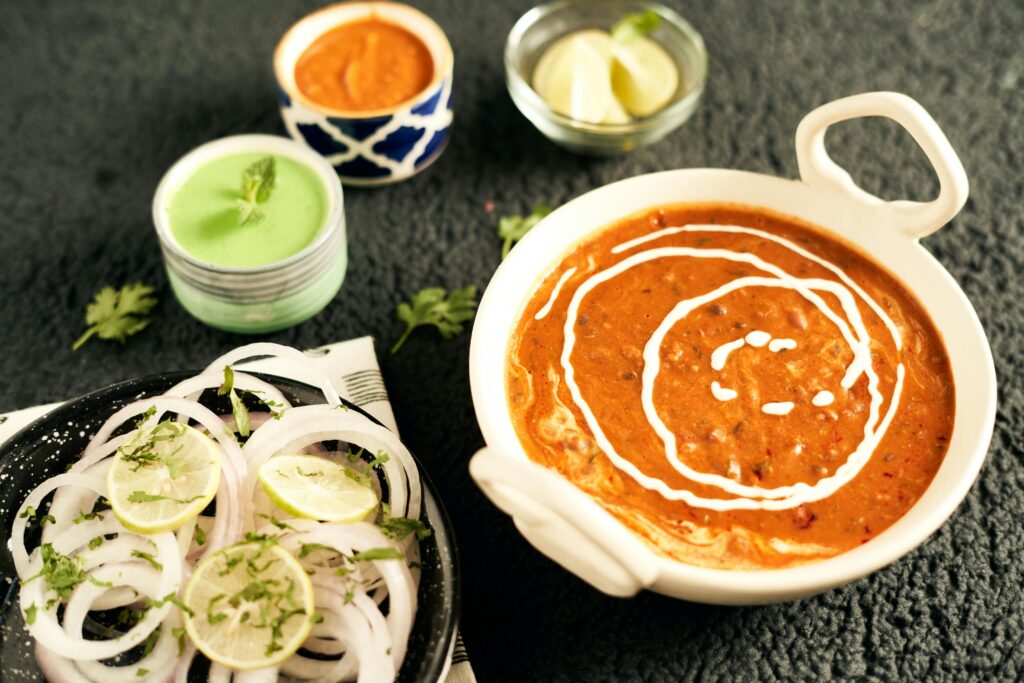Chutneys are one of those quietly brilliant additions to a meal – often sitting on the edge of the plate yet stealing the show the moment you taste them. With roots in the Indian subcontinent, they’ve been around for centuries – passed down generation to generation, sometimes adopting flavours and techniques from around the world as global borders become ever more permeable – made from all kinds of ingredients: herbs, fruits, spices, and vegetables, each blended into a punchy, flavourful mix.
«Chutneys can be fiery and bold and also sweet and mellow, yet these complex layers of taste will all dance a tango on your taste buds! » says Bea Vakharia, analyst at Buchler Phillips, who tempts us this month with a trio of deliciously fabulous chutneys: mango, coriander mint & coconut.
Originally served alongside rice, curries, flatbreads and traditional snacks, chutneys have evolved into incredibly versatile condiments. Today, they show up as dips for appetisers like samosas and chips, spreads for sandwiches and wraps, dressings for salads and even glazes for meats and roasted vegetables. A spoonful of green chutney adds freshness and bite; a dollop of mango chutney brings warmth and sweetness that pairs beautifully with cheese or grilled dishes.
They may not be the main event, but chutneys have a way of turning an ordinary bite into something memorable.
Bea’s chutney recipes below are all about big flavours and simple steps. From tangy to spicy to sweet, they cover a range of moods and meals – great for dipping, spreading, or just adding a little something extra to your plate. Feel free to tweak them based on what you’ve got on hand. They’re forgiving, endlessly adaptable – go ahead and give it a try!

Recipe 1: Mango Chutney
You can make this spicy by adding chilli to taste. Use this chutney as a dip for fritters, chips & poppadom, a marinade or glaze.
200 ml full-fat coconut milk
50g unsweetened dried mango, roughly chopped
200g semi-ripe mango, peeled and diced
1 large clove garlic
1/4 tsp ground black pepper
1/4 tsp ground turmeric
1/2 tsp lime zest
1/2 tsp salt
50 ml water
2 tbsp red onion, finely diced
1. Heat the coconut milk in a small saucepan.
2. Add all the other ingredients (except the water and diced onion), bring the mixture to a boil and cover with a lid to simmer – until the dried mango has softened. Allow to cool.
3. Place the mixture into a blender and blend until smooth and creamy. You may need to add some water to adjust the consistency. Stir in the chopped onions.
4. Pour the chutney into a bowl and cover. Chill before serving.
Recipe 2: Coriander Mint Chutney
You can mix in yogurt for a delightful alternative dip or as a side to various rice dishes (a version of raita!).
A Bunch of coriander
A handful of mint leaves (can add more or be omitted)
A handful of peanuts
3 thin green chillies (add or reduce to taste)
1 large clove garlic, peeled (can be omitted but tastes great!)
Fresh lemon juice, to taste
Salt, to taste
Sugar, not required unless preferred
65 ml ice cold water, for consistency
1. Blend all the ingredients in a blender. Can add water for consistency but recommended not to add water to the batch to be stored.
2. Add water to make a dipping sauce for poppadoms, fritters & samosas.
3. Add to wraps and sandwiches as a spread (do not thin out too much – or use straight without adding water).
Recipe 3: Coconut Chutney
This chutney should be used fresh – doesn’t keep very well.
1/2 cup tightly packed freshly grated coconut to grinder
1 to 2 chopped green chillies (depending on your heat preference)
1/2 inch chopped ginger or 2 small cloves of garlic
2 tbsp chana dal (split chickpea), roasted (you can skip this if you do not have it)
Salt, to taste
3-4 tbsp water, adjust consistency to preference
1. Grind to a fine and smooth consistency. If the blade is unable to grind or the chutney looks thick, then you can add 1-2 tbsp more water or as needed.
2. Remove the chutney and adjust for salt if needed.
Tempering
1. Heat ½ tbsp sesame oil over low heat in a pan. Can also use sunflower oil or any neutral flavoured oil.
2. Add ½ tsp mustard seeds and let them begin to crackle.
3. Add ½ teaspoon urad dal (split and husked black gram); can skip if unavailable.
4. Add ½ teaspoon cumin seeds; can skip if preferred.
5. Stir often and fry keeping the flame to a low.
6. The urad dal should start becoming golden and the cumin seeds will brown.
7. Once the urad dal begins to turn to a golden colour, then add 1 dry red chilli (broken and seeds removed), 9-10 curry leaves and a pinch of asafoetida. Stir and fry for a couple of seconds till the curry leaves become crisp and the red chilli changes colour.
8. Switch off the flame and immediately pour the entire tempering together with the oil on the ground coconut chutney in the bowl and mix.
Variations of coconut chutney: add fresh mint leaves, coriander leaves, garlic, curd (yogurt), tamarind, tomatoes, onions, almonds, carrots, beetroot, unripe mangoes, peanuts, capsicum, and greens like spinach.
Buchler Phillips is a UK based independent boutique firm with an impeccable Mayfair heritage, specialising in corporate recovery, turnaround, restructuring, insolvency.
